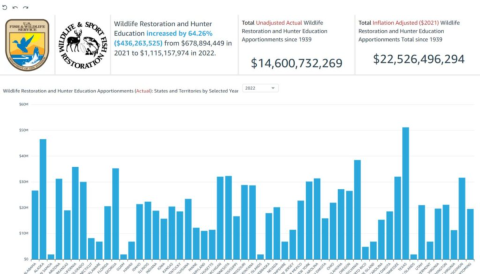This post was originally published here: https://www.fws.gov/story/2022-10/new-dashboards-make-decades-license-and-apportionment-data-more-accessible
Written by Cindy Sandoval
The Wildlife and Sport Fish Restoration Program (WSFR) has launched new data dashboards to give partners and the public access to hunting and fishing license data and apportionment figures, with decades of information. These data sets provide an important source for historical license information and show the amount of apportionment funds provided to state and territorial fish and wildlife agencies through the years.
“The new WSFR data dashboards were created to provide easy access to important data,” said Jerry Leonard economist for WSFR. “By using the new data dashboards, we can visually represent decades of data by state or across the nation, allow users to download excel versions of the data, and show both actual and inflation adjusted amounts apportioned to a state or territory.” Often states and researchers use this data to view trends in license sales or to calculate the economic impact of hunting and fishing.
The hunting and fishing license data represented in the dashboard is supplied to WSFR for annual certification by state fish and wildlife agencies. “The state license data is vital because the U.S. Fish and Wildlife Service uses the data in statutory formulas to allocate funds for WSFR managed programs including The Wildlife Restoration Program and The Sport Fish Restoration Program,” said Tom Decker, WSFR Branch Manager for Communications, Analysis and Partnerships. In FY2021, the WSFR program supported healthy fish and wildlife populations, fostered habitat protection, and increased access to clean water through over $1.1 billion in grants to state partners.
These apportionments, supported by a manufacture excise tax on sporting arms, ammunition, archery equipment and a tax on fuel, have provided conservation and management assistance for the nation’s wildlife and wild places since 1937. “Since the passing of The Pittman-Robertson Wildlife Restoration Act and later The Dingell-Johnson Sport Fish Restoration Act, excise taxes collected have been used by our partners to provide hunter and angler education to 2.5 million students, supported over 500 mammal and bird species, and provided public access and habitat management on over 35 million acres of land in the United States,” added Decker.
It is important to note, that the license data in the dashboard does not represent the number of hunters or anglers that participated across the United States in a particular year. Not everyone needs to buy a license; depending on the state or territory, youth, seniors, those with health conditions or impairments, commercial charters, landowners, and military veterans may be exempt. Moreover, some hunters and anglers buy licenses in multiple states and not every license buyer goes afield.
“Users of the dashboards may also notice that some cells for a state in a particular year are empty,” explained Leonard. “This does not mean that the amount for that cell is zero, it instead means that we might not have access to that historic data set yet.” As more information becomes available and is digitized, the WSFR team will update the data in the existing dashboard. The team hopes to create similar dashboards for additional grant programs like State Wildlife Grants.
“These data dashboards and our continued web-based enhancements are expanding the tools used by WSFR to highlight our partnerships with states and industry to conserve wildlife for current and future generations,” added Decker. “It is important data for grant program eligibility, and it is equally important data to show the value of our WSFR Programs and how annual apportionments support state conservation efforts.” The current data dashboards can be accessed at:
- Wildlife Restoration and Hunter Education Apportionments
- Sport Fish Restoration Apportionments
- Hunting Licenses, Holders, and Costs by Apportionment Year
- Fishing Licenses, Holders, and Costs by Apportionment Year
-------------------------------------------------------------------------------------------------------------------------------------------------------------
Starting in the fall of 2022, the TRACS License Certification and Apportionments Module has been used by state fish and wildlife agency license managers to enter, review, certify, and submit the number of paid hunting and fishing license holders on an annual basis. Certified hunting and fishing license holder figures are used in the calculation of grant funding apportionments available to each state and insular area. WSFR headquarters staff to run preliminary and final apportionments. Apportionments refer to amount of federal funds distributed to fish and wildlife agencies in the States, District of Columbia (Sport Fish Only) and Insular Areas, based on statutory formulas under the authorizing legislation (Wildlife Restoration Act, Sport Fish Restoration Act and State Wildlife Grant Program). Each grant program has a factor set that is used in its apportionment formula. To learn more, visit the License Certifications and Apportionments Overview page.
